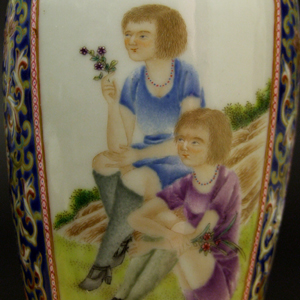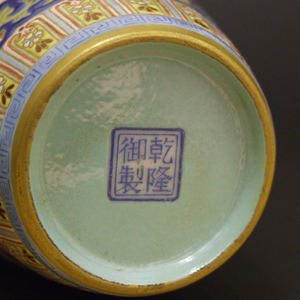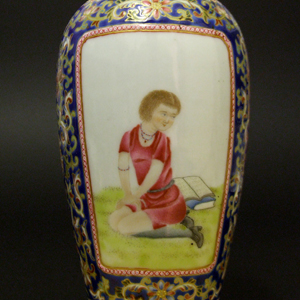
REPUBLIC PERIOD 1911 – 1949 Famille Rose Porcelain
A Rare Republic Period (1911-1949) European Subject Imperial Style Vase c.1925. The Richly Enamelled Deep Blue Ground has Two Panels Depicting Young Western Women in Fashionable Cloths. The Base has a Pseudo-Qianlong Mark in a Double Square Set in a Turquoise Ground.
SOLD
- Condition
- Perfect.
- Size
- Height : 20 cm (8 inches)
- Provenance
- N/A
- Stock number
- 22571
- References
- For a relate pair of Imperial 18th century Qianlong Mark and Period purple ground enamel vase see : China for the West, Chinese Porcelain & other Decorative Arts for Export Illustrated from the Mottahedeh Collection (David S. Howard and John Ayers, Sotheby`s,1978) Volume 2, page 636, plate 663.
Information
This unusual Republic vase has it`s origin`s in the finest Imperial porcelain produced for the Emperor Qianlong (1736-1795) in the imperial workshops at Beijing. Exquisitely enamelled porcelain and enamel was produced in a very similar style to the present example, some of these had European figure subjects like the present example but of cause they were dressed in the fashionable clothes of the 18th century not the 1920`s. The women depicted on this Republic vase epitomize the new look of better off women of the time with their hair in the convenient new style, the bob, which started, probably in France in around 1910. However it was made popular and given it`s name in 1915 with the debut of the `Castle Bob`, named after the celebrated ballroom dancer Irene Castle.
The original vases of this type were, as mentioned, made for the imperial court, this vase was probably made for the large number of Westerners in Shanghai, Peking and other towns. Although most of the Europeans and Americans in these towns had a very easy life the Chinese didn`t, there were even notices on well manicured lawns in public parks saying "No Dogs or Chinese". To add to the insult these lawns would have been maintained by the Chinese.
Although this vase is not `Export Ware` we thought that it was an interesting addition to our exhibition as it was made for Westerners.
Famille Rose Porcelain :
China`s ceramics industry has for thousands of years be connected to events in the world outside it`s own borders. Importing materials, assimilating foreign ideas, foreign tastes and inventions, as well as making ceramics for cultures completely foreign to it`s own tastes and ethos China has always adapted it`s ceramics industry to fit the needs of it clients who ever they may be. It was during the Qing dynasty, especially from the late 17th century, that the Chinese became especially interested in Western technology and science. Famille Rose enamels were developed as a consequence of this interaction, the Chinese referred to these enamel colours as foreign colours from as early as 1734 but there origin can be traced back to the 1720`s if not earlier. The impetus for the development of this new palette was the direct involvement emperor Kangxi (1662-1722) who desired to improve expertise in the manufacture of all crafts, especially in relation to learning about technology from abroad. Famille Rose enamels were different to the earlier Famille Verte enamels in a number of ways, the most obvious being the colours used, but the enamels themselves were different in that the translucent colours of the earlier palette were making way to thicker impasto opaque enamels of Famille Rose. The rose colour that gives its name to this colour scheme is created from colloidal gold (a suspension or colloid of sub-micrometre-sized particles of gold in a fluid). This ruby red colour was augmented by two other newly introduced coloured enamels, an opaque white which was made from fine crystals of lead arsenate, the other new colouring agent was lead stannate used for the opaque yellow. These colours, while new to China, were certainly not new to Europe but the effect of them on porcelain certainly was new. Famille Rose didn`t entirely replace Famille Verte as such but it certainly became far more popular. Famille Rose enamel was used in the Imperial workshops to paint some of the most complex intricate designs ever carried out on Chinese porcelain, it was also used for Chinese taste or domestic market porcelain, but was also used to decorate a vast array of Chinese export porcelain of all shapes and sizes.





